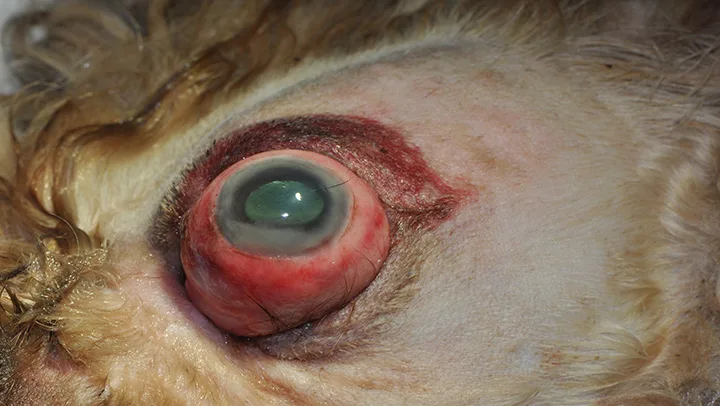Step-by-Step Guide to Proptosis Reduction
Caryn Plummer, DVM, DACVO, University of Florida

Proptosis in an Australian shepherd puppy
Proptosis of the globe (Figure 1) is a true ocular emergency. The eyelids become trapped behind the equator of the globe, usually from trauma. The eyelid margins are seldom visible, and the patient is unable to blink and protect the cornea. Treatment delay and resultant elongated globe exposure can increase the likelihood of corneal ulceration, retrobulbar edema, and hemorrhage, raising the risk for blindness from globe perforation or optic nerve damage.
The force necessary to proptose a globe varies with orbital anatomy. Proptosis occurs more easily in brachycephalic breeds (both canine and feline) than in mesocephalic or dolichocephalic breeds, improving the odds for sight and globe retention in the former. The prognosis for vision is generally guarded to poor, but prompt treatment may save the globe. Enucleation may be best if the globe is ruptured or ≥2 extraocular muscles or the optic nerve is avulsed. If the status of the eye and muscles cannot be determined, proptosis should be reduced and a temporary tarsorrhaphy placed. The globe can be removed later if necessary, but it cannot be replaced.
Following surgery, the eye should be monitored for signs of keratoconjunctivitis sicca, a common sequela that requires frequent, diligent, and long-term medical therapy even if the globe has been rendered nonvisual. If owners are unwilling or unable to provide long-term care following resolution of proptosis, enucleation at initial presentation may be warranted.
Step-by-Step: Proptosis Reduction
What You Will Need
Small scissors (Stevens tenotomy, strabismus, Mayo, or Metzenbaum)
Needle drivers
Small forceps (Bishop-Harmon, toothed)
Nonabsorbable suture (4-0, nylon or silk; 3-0 to 4-0 for dogs with thick eyelid margins [eg, English bulldogs])
Stents (pieces of wide rubber band material or IV tubing or buttons)
Topical ophthalmic antibiotic or lubricating ointment

STEP 1
Administer systemic analgesic and protect the cornea by applying a topical lubricant (eg, ophthalmic antibiotic ointment) immediately on presentation. Assess the patient’s general physical condition; when the patient is stable, induce general anesthesia. Evaluate the globe’s condition, particularly the cornea, to determine whether globe replacement or enucleation is indicated; check for intraocular muscle integrity, vision, hyphema, and pupillary light reflex. Clip and prepare eyelids and corneoconjunctival surfaces; remove debris from the cornea and conjunctiva with sterile saline or lactated Ringer’s solution.
Author Insight
To clean and prepare ocular surfaces and conjunctival fornices, use dilute povidone–iodine with saline to 0.5% (light brown, resembling weak tea). Swab lid margins and fornices (if accessible) with a sterile cotton-tipped applicator. Rinse the povidone–iodine solution from the eye with sterile saline or eye wash. Do not apply povidone–iodine scrub or other chemical preparations (eg, chlorhexidine) to ocular surfaces; doing so can cause corneoconjunctival ulceration.
Editor's note: This article was originally published in September 2013 as "Proptosis Reduction."